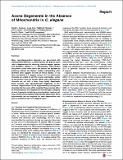Axons Degenerate in the Absence of Mitochondria in C. elegans
Author(s)
Rawson, Randi L.; Yam, Lung; Weimer, Robby M.; Bend, Eric G.; Clark, Scott G.; Jorgensen, Erik M.; Hartwieg, Erika A.; Horvitz, Howard Robert; ... Show more Show less
DownloadHorvitz_Axons degenerate.pdf (1.637Mb)
PUBLISHER_POLICY
Publisher Policy
Article is made available in accordance with the publisher's policy and may be subject to US copyright law. Please refer to the publisher's site for terms of use.
Terms of use
Metadata
Show full item recordAbstract
Many neurodegenerative disorders are associated with mitochondrial defects [1, 2 and 3]. Mitochondria can play an active role in degeneration by releasing reactive oxygen species and apoptotic factors [4, 5, 6 and 7]. Alternatively, mitochondria can protect axons from stress and insults, for example by buffering calcium [8]. Recent studies manipulating mitochondria lend support to both of these models [9, 10, 11, 12 and 13]. Here, we identify a C. elegans mutant, ric-7, in which mitochondria are unable to exit the neuron cell bodies, similar to the kinesin-1/unc-116 mutant. When axons lacking mitochondria are cut with a laser, they rapidly degenerate. Some neurons even spontaneously degenerate in ric-7 mutants. Degeneration can be suppressed by forcing mitochondria into the axons of the mutants. The protective effect of mitochondria is also observed in the wild-type: a majority of axon fragments containing a mitochondrion survive axotomy, whereas those lacking mitochondria degenerate. Thus, mitochondria are not required for axon degeneration and serve a protective role in C. elegans axons.
Date issued
2014-03Department
Massachusetts Institute of Technology. Department of BiologyJournal
Current Biology
Publisher
Elsevier
Citation
Rawson, Randi L., Lung Yam, Robby M. Weimer, Eric G. Bend, Erika Hartwieg, H. Robert Horvitz, Scott G. Clark, and Erik M. Jorgensen. “Axons Degenerate in the Absence of Mitochondria in C. Elegans.” Current Biology 24, no. 7 (March 2014): 760–765. © 2014 Elsevier Ltd.
Version: Final published version
ISSN
09609822
1879-0445